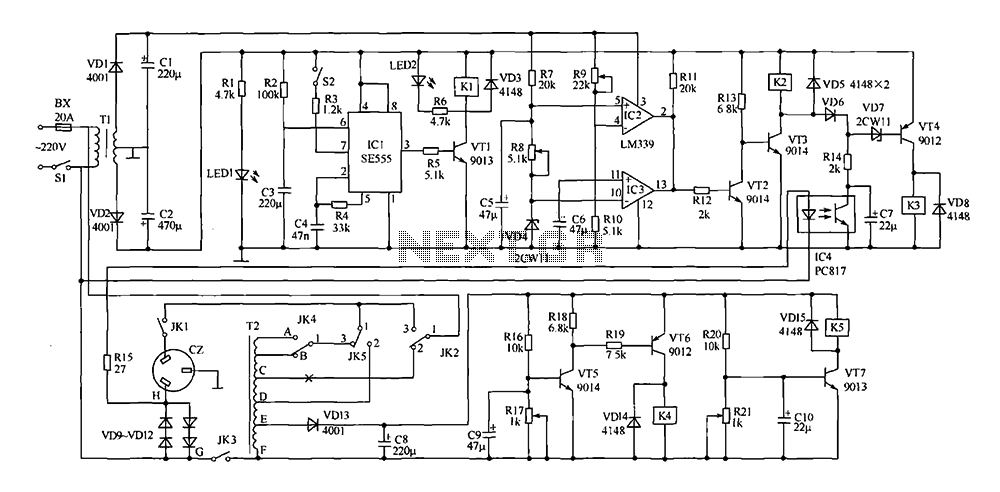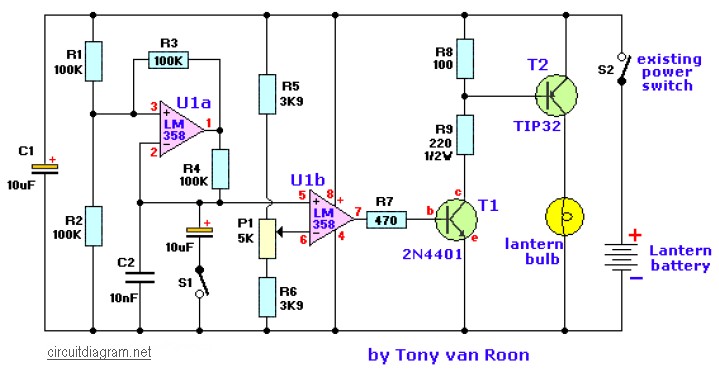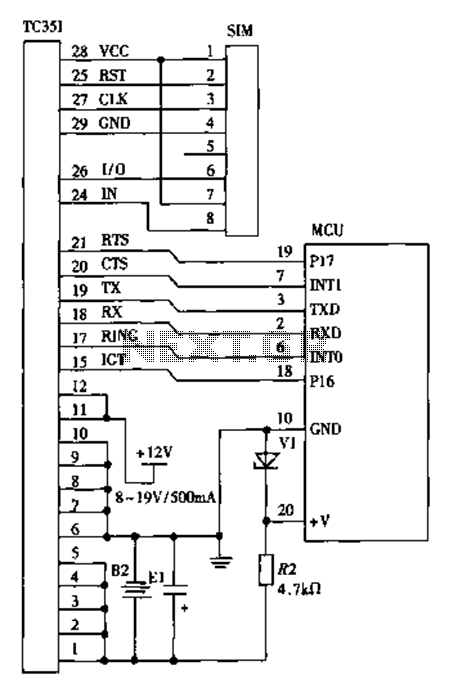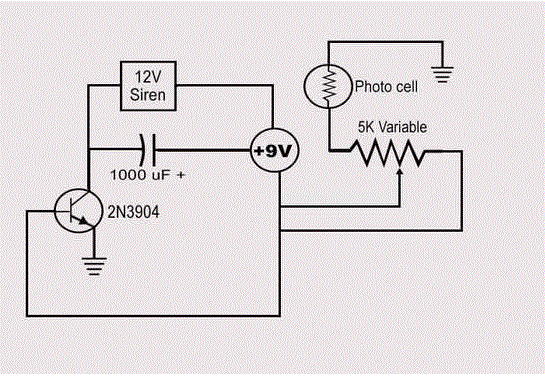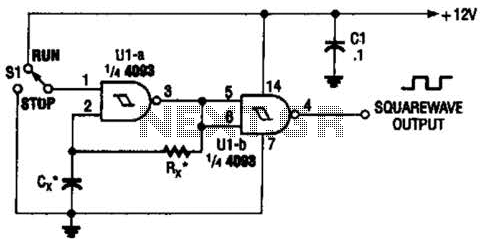
transformer circuit

A static device that couples two circuits to transfer alternating current (AC) from one circuit to another through electromagnetic induction. The current maintains the same frequency but may vary in voltage, phase, or impedance values. A transformer consists of two or more wire coils, or windings, without any moving parts. The voltage induced in a coil on a transformer is proportional to the number of turns around the core. It is primarily used to change the voltage in an alternating current (AC) but can also serve as an electrical isolator while maintaining the same voltage. The most common type is the laminated core transformer, typically found in power supplies. This transformer is made of steel laminations wrapped with two coils of wire, and the ratio of windings between the "primary" input coil and the "secondary" output coil determines the voltage change. For instance, if the primary has 1,000 windings and the secondary has 100, an input of 120 volts is transformed to 12 volts.
Transformers come in various architectures and sizes. Small transformers are used in many devices that plug into wall outlets to create low DC voltage for electronic gadgets, while large transformers can transmit 50,000 volts of AC across the national power grid. All transformers operate on the principle of electromagnetic induction. The changing current in the primary coil induces a voltage across the secondary coil.
In switching power supplies, the greater the current required to power a device, the thicker the wire in the coils and the larger the transformer needed. However, using a high frequency allows for a reduction in the number of windings, resulting in a smaller transformer. This is achieved by converting the incoming voltage to DC (rectified) and using a high-frequency oscillator to pulse a transistor, which then passes the rectified voltage as square waves into a "pulse transformer." The on/off DC pulses produce a changing current in the primary coil, similar to how AC operates. This square wave generation effectively transforms a power supply into a "switching power supply." High-frequency oscillators can generate frequencies ranging from 1 kHz to 200 kHz.
In summary, the transformer is a critical component in electrical systems, enabling voltage transformation and electrical isolation through electromagnetic induction. Its design and operation principles are fundamental for various applications, particularly in power supply systems. The efficiency and effectiveness of transformers can significantly influence the performance of electronic devices and power distribution networks.A static device that couples two circuits for the purpose of transferring alternating current (AC) from one circuit to another by electromagnetic induction. The current remains at the same frequency, but may change in voltage, phase, or impedance values. A transformer comprises two or more wire coils, or windings, but no moving parts. The voltage in duced in a coil on a transformer is proportional to the number of turns around the core. See also AC, frequency, impedance, inductance, phase, and voltage. A device that is mostly used to change the voltage in an alternating current (AC); however, it can also be used to maintain the same voltage but act as an electrical isolator. The most common type is the laminated core transformer found in power supplies. Made of steel laminations wrapped with two coils of wire, the ratio of windings between the "primary" input coil and the "secondary" output coil determines the voltage change.
For example, if the primary has 1, 000 windings and the secondary 100, an input of 120 volts is changed to 12v. Via ElectroMagnetic Induction There are numerous transformer architectures, and they span the size gamut.
Small ones are used in the myriad black boxes that plug into the wall and create low DC voltage for every electronic gadget, while transformers weighing tons are used to transmit 50, 000 volts of AC over the nation`s power grid. However, they all work via electromagnetic induction. The changing current in the primary coil induces a voltage across the secondary coil. Switching Power Supplies The greater the current needed to power the device, the thicker the wire in the coils and the larger the transformer.
However, if a high frequency is used, the number of windings can be reduced to make the transformer small. To accomplish this, the incoming voltage is converted to DC (rectified), and a high-frequency oscillator pulses a transistor that passes the rectified voltage as square waves into a "pulse transformer.
" The on/off DC pulses cause the changing current in the primary coil just the same as AC does. This square wave generation turns a power supply into a "switching power supply. " See power adapter, power supply and wall wart. In order to reduce the number of windings in transformer coils, a high frequency pulse transformer is used. This is a hypothetical example; voltages and frequencies vary. For example, the oscillator can generate frequencies from 1 kHz to 200 kHz. Following is a simplified circuit diagram of this power supply. 🔗 External reference
Transformers come in various architectures and sizes. Small transformers are used in many devices that plug into wall outlets to create low DC voltage for electronic gadgets, while large transformers can transmit 50,000 volts of AC across the national power grid. All transformers operate on the principle of electromagnetic induction. The changing current in the primary coil induces a voltage across the secondary coil.
In switching power supplies, the greater the current required to power a device, the thicker the wire in the coils and the larger the transformer needed. However, using a high frequency allows for a reduction in the number of windings, resulting in a smaller transformer. This is achieved by converting the incoming voltage to DC (rectified) and using a high-frequency oscillator to pulse a transistor, which then passes the rectified voltage as square waves into a "pulse transformer." The on/off DC pulses produce a changing current in the primary coil, similar to how AC operates. This square wave generation effectively transforms a power supply into a "switching power supply." High-frequency oscillators can generate frequencies ranging from 1 kHz to 200 kHz.
In summary, the transformer is a critical component in electrical systems, enabling voltage transformation and electrical isolation through electromagnetic induction. Its design and operation principles are fundamental for various applications, particularly in power supply systems. The efficiency and effectiveness of transformers can significantly influence the performance of electronic devices and power distribution networks.A static device that couples two circuits for the purpose of transferring alternating current (AC) from one circuit to another by electromagnetic induction. The current remains at the same frequency, but may change in voltage, phase, or impedance values. A transformer comprises two or more wire coils, or windings, but no moving parts. The voltage in duced in a coil on a transformer is proportional to the number of turns around the core. See also AC, frequency, impedance, inductance, phase, and voltage. A device that is mostly used to change the voltage in an alternating current (AC); however, it can also be used to maintain the same voltage but act as an electrical isolator. The most common type is the laminated core transformer found in power supplies. Made of steel laminations wrapped with two coils of wire, the ratio of windings between the "primary" input coil and the "secondary" output coil determines the voltage change.
For example, if the primary has 1, 000 windings and the secondary 100, an input of 120 volts is changed to 12v. Via ElectroMagnetic Induction There are numerous transformer architectures, and they span the size gamut.
Small ones are used in the myriad black boxes that plug into the wall and create low DC voltage for every electronic gadget, while transformers weighing tons are used to transmit 50, 000 volts of AC over the nation`s power grid. However, they all work via electromagnetic induction. The changing current in the primary coil induces a voltage across the secondary coil. Switching Power Supplies The greater the current needed to power the device, the thicker the wire in the coils and the larger the transformer.
However, if a high frequency is used, the number of windings can be reduced to make the transformer small. To accomplish this, the incoming voltage is converted to DC (rectified), and a high-frequency oscillator pulses a transistor that passes the rectified voltage as square waves into a "pulse transformer.
" The on/off DC pulses cause the changing current in the primary coil just the same as AC does. This square wave generation turns a power supply into a "switching power supply. " See power adapter, power supply and wall wart. In order to reduce the number of windings in transformer coils, a high frequency pulse transformer is used. This is a hypothetical example; voltages and frequencies vary. For example, the oscillator can generate frequencies from 1 kHz to 200 kHz. Following is a simplified circuit diagram of this power supply. 🔗 External reference
Warning: include(partials/cookie-banner.php): Failed to open stream: Permission denied in /var/www/html/nextgr/view-circuit.php on line 713
Warning: include(): Failed opening 'partials/cookie-banner.php' for inclusion (include_path='.:/usr/share/php') in /var/www/html/nextgr/view-circuit.php on line 713
